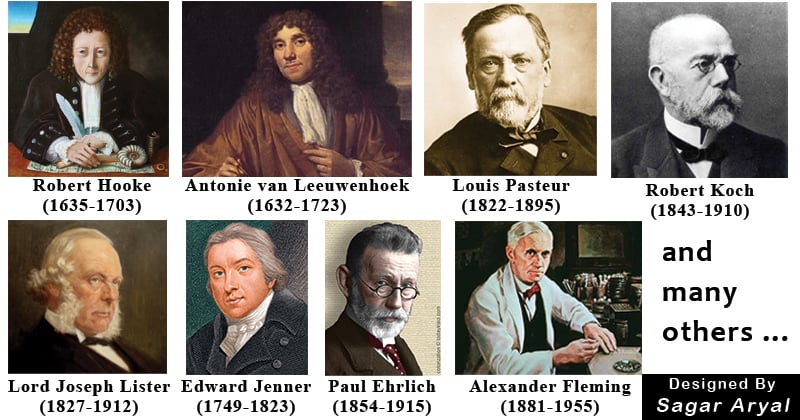Which of the Following Scientists First Challenged Spontaneous Generation
Also the archaic theory that utilized this process to explain the origin of life. The first major blow against it was brought about by the.

Spontaneous Generation Microbiology
Spallanzani tried to disprove spontaneous generation by performing boiled broth experiments.

. Although this was rejected for more complex forms such as mice which were observed to be born from mother mice after they copulated with father mice there remained doubt for such things as insects. His hypothesis was that flies do not spontaneously generate from meat. Spontaneous generation the hypothetical process by which living organisms develop from nonliving matter.
In England John Needham challenged Redis findings by conducting an experiment in which he placed a broth or gravy into a bottle heated the bottle to kill anything inside then sealed it. A scientist has two samples- the first is a prion sample while the second is a varied sample. He expanded upon the investigations of predecessors such as Francesco Redi who in the 17 th century had performed experiments based on the same principles.
In 1859 the year English naturalist Charles Darwin published his On the Origin of Species Pasteur decided to settle this dispute. Francesco Redi 1668 disproved spontaneous generation by finding that worms on rotting meat came from eggs laid by flies not decaying meat covered meat with gauze no flies. In some experiments he boiled broth and sealed the flasks.
The Pasteur-Pouchet Debate Bulletin of the History of Medicine 48 1974. Louis Pasteur is credited with conclusively disproving the theory of spontaneous generation with his famous swan-neck flask experiment. Or so he thought.
Redi successfully demonstrated that the maggots came from fly eggs and thereby helped to disprove spontaneous generation. Prominent scientists designed experiments and argued both in support of John Needham and against Lazzaro Spallanzani spontaneous generation. He subsequently proposed that life only comes from life.
A now discredited notion that living organisms spontaneously originate directly from nonliving matter A difficulty that we have forgotten lay in the widespread belief in spontaneous generation. Farley John and Gerald L. According to that theory pieces of cheese and bread wrapped in rags and left in a dark corner for example were thus thought to produce mice because after several weeks there were mice in.
The germ theory of disease was also reinforced by Anton Van Leeuwenhoek the first microbiologist to view microorganisms under a microscope. Aristotle had written that flies worms and other small animals originated spontaneously from putrefying matter. Conflicting results between labs.
Pasteurs set of experiments irrefutably disproved the theory of spontaneous generation and earned him the prestigious Alhumbert Prize from the Paris Academy of Sciences in 1862. He conducted one of the first examples of a modern experiment using controls. -took another 200 years.
French 1864 Spontaneous Generation. What type of molecule would she look for to do this. Today spontaneous generation is generally accepted to have been decisively dispelled during the 19 th century by the experiments of Louis Pasteur.
Prominent scientists designed experiments and argued both in support of John Needham and against Lazzaro Spallanzani spontaneous generation. He subsequently proposed that life only comes from life. Up to 24 cash back Francisco Redi.
While both supported the idea of spontaneous generation Italian abbot and physiologist Lazzaro Spallanzani maintained that life could never spontaneously generate from dead matter. After this experiment people were willing to acknowledge that larger organisms didnt arise by spontaneous generation but had to. The Spontaneous Generation Controversy from Descartes to Oparin.
Maggots arose only where flies were able to lay eggs. As a result Redii disproved the idea of spontaneous generation. In others he boiled broth sealed the flasks then cracked the seals.
Century supported spontaneous generation Fry 2000 18-19. However the samples are in unlabeled tubes. February 18 1626-March 1 1697.
Science Politics and Spontaneous Generation in Nineteenth-Century France. Following the abandonment of Aristotelian doctrines and the begin-ning of modern science in what became called the scientific revolution the idea of spontaneous generation too became increasingly challenged and disputed. Marcus Antonius Von Plenzic later backed Richard Bradleys hypothesis that diseases were caused by microbes.
A French scientist who proved that micro organisms was carried by dust not air. Johns Hopkins University Press 1977. The idea that organisms originate directly from nonliving matter.
Louis Pasteur is credited with conclusively disproving the theory of spontaneous generation with his famous swan-neck flask experiment. Louis Pasteur - One of the first to disprove spontaneous generation. Explain how Francesco Redi 1668 tried to disprove the theory of spontaneous generation through the first controlled experiment.
This experiment disproved the idea of spontaneous generation for larger organisms. Redi experiment 1665 As late as the 17th century some biologists thought that some simpler forms of life were generated by spontaneous generation from inanimate matter. The scientist wants to run a sample analysis to determine which tube contains thermion sample and which one contains the viroid.
Francesco Redi was an Italian Physician and Poet who assisted in paving the way to disproving the theory of spontaneous generation through various experiments in the 17th century. In a subsequent lecture in 1864 Pasteur articulated Omne vivum ex vivo.

History Of Microbiology And Contributors In Microbiology



Comments
Post a Comment